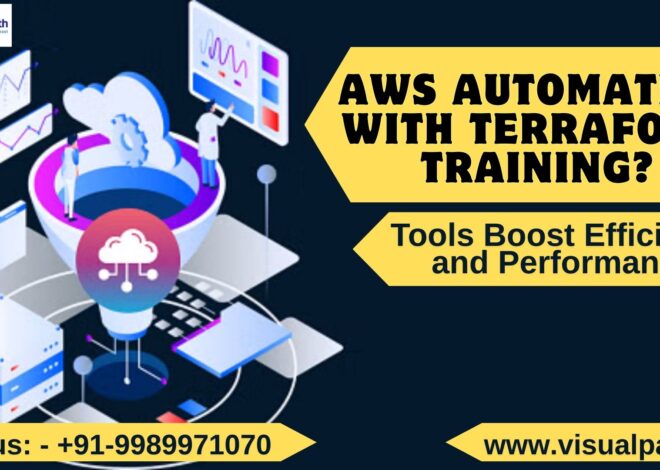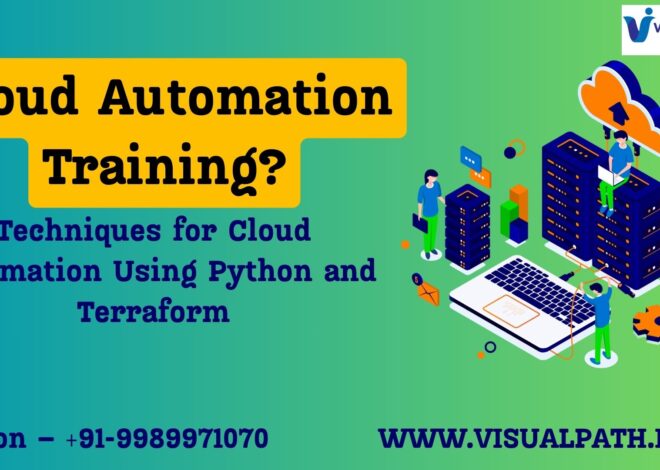
Cloud Automation Training? Python and Terraform for Multi-Cloud Automation Tips and Best Practices
Cloud automation Aws Automation with Terraform Training has become essential as organizations increasingly operate in multi-cloud environments. Effective multi-cloud automation enables businesses to optimize their resources, reduce redundancy, and improve service delivery times. Python and Terraform are two prominent tools for achieving cloud automation, particularly in an Amazon Web Services (AWS) context. With the right training, professionals can leverage AWS Automation with Terraform Training and AWS Cloud Automation Using Terraform Training to manage complex multi-cloud infrastructures seamlessly.
This article explores the benefits of using Python and Terraform for cloud automation, best practices for multi-cloud management, and tips for getting the most out of your AWS Automation with Terraform Training. We’ll cover essential subtopics, including Python’s versatility in automation, Terraform’s infrastructure-as-code capabilities, and tips for efficient multi-cloud automation setups.
Introduction to Multi-Cloud Automation with Python and Terraform
Python and Terraform are widely utilized for cloud automation due to their adaptability, scalability, and ease of use. Python excels in scripting and API integrations, while Terraform enables declarative infrastructure management through infrastructure-as-code (IaC) principles.
- Python for Automation: Python is an accessible yet powerful programming language suitable for automating workflows, integrating APIs, and managing cloud resources. As an open-source language, it boasts extensive libraries and frameworks tailored for cloud automation, such as Boto3 for AWS.
- Terraform’s Role in IaC: Terraform, developed by HashiCorp, enables professionals to automate infrastructure provisioning across multiple cloud environments. With IaC, teams can define and version their infrastructure in configuration files, facilitating smoother deployments and minimizing human error.
Benefits of AWS Automation with Terraform Training
Training in AWS Automation with Terraform Training offers a range of benefits for professionals. Terraform’s declarative approach allows users to define their desired infrastructure state, which Terraform then matches across multiple cloud providers. This flexibility is crucial for building resilient, efficient, and consistent cloud infrastructures.
Key Benefits:
- Streamlined Infrastructure Management: Terraform’s code-based infrastructure management simplifies complex workflows, saving time and resources.
- Cross-Platform Compatibility: Terraform supports multi-cloud deployments, making it ideal for organizations using AWS, Azure, and Google Cloud simultaneously.
- Consistent Deployments: Terraform automates deployments and maintains infrastructure consistency across environments, reducing the risk of configuration drift.
- Scalability and Resilience: Terraform’s modular approach helps organizations scale their infrastructure in response to business demands.
Training in AWS Cloud Automation Using Terraform equips professionals with the skills to create, update, and maintain cloud resources efficiently.
Essential Tips for Multi-Cloud Automation
Successful multi-cloud automation requires more than technical skills—it demands strategic planning and adherence to best practices. Here are some tips for maximizing efficiency with AWS Cloud Automation Using Terraform Training and AWS Automation with Terraform Training:
- Standardize Your Automation Scripts: Using standard templates and scripts for Terraform configurations ensures consistency across environments. Standardization also facilitates easier debugging and faster onboarding for new team members.
- Integrate Testing in Automation: Continuous testing of Terraform code minimizes errors and ensures that infrastructure changes align with organizational policies.
- Implement Robust Access Control: Secure your infrastructure by implementing access controls and least-privilege policies for Terraform and Python scripts. This practice safeguards sensitive data and prevents unauthorized access to cloud resources.
- Utilize Environment-Specific Variables: Use environment variables to adapt automation scripts for development, testing, and production environments. This approach simplifies deployments and minimizes configuration errors.
Best Practices for AWS Cloud Automation Using Terraform Training
Mastering AWS Cloud Automation Using Terraform Training entails more than understanding individual commands—it requires knowledge of best practices for efficient cloud automation. Here are some best practices to enhance your automation skills:
- Use Terraform State Management Properly: Terraform keeps track of infrastructure changes with a state file. For multi-cloud setups, use remote storage solutions like AWS S3 with state locking to avoid conflicts.
- Implement Error Logging and Monitoring: Real-time monitoring tools like AWS CloudWatch or third-party services like Datadog can track automation tasks and identify errors.
- Minimize Hardcoded Values: Use variables instead of hardcoded values for resource names, regions, or instance types, which promotes flexibility in different environments.
- Employ Modular Automation Design: Modularize your Terraform and Python scripts to facilitate reuse and minimize redundancy in your infrastructure configurations.
- Conduct Regular Audits and Security Checks: Conduct periodic audits to identify security vulnerabilities or misconfigurations in your automation processes.
Following these best practices can make your multi-cloud automation setup more efficient, secure, and manageable. Enrolling in AWS Automation with Terraform Training can enhance your ability to implement these practices effectively.
Conclusion:
The Future of Multi-Cloud Automation with Python and Terraform
Incorporating Python and Terraform into cloud automation opens doors to more efficient multi-cloud management. With AWS Automation with Terraform Training, professionals can manage complex infrastructures, automate provisioning, and ensure consistent deployments across diverse environments. By mastering Python’s scripting capabilities and Terraform’s IaC approach, professionals can streamline processes and reduce errors, ultimately leading to higher productivity.
Visualpath is one of the Best Aws Cloud Automation Using Terraform Training providing real-time Projects with highly skilled and certified trainers with 15+ years of experience. Cloud Automation Courses is specially designed for IT developers.
Enroll Now!
Call: +91-9989971070
Course Covered:
Ansible, Terraform, Microsoft Azure, Puppet, Chef, AWSCloudFormation, Kubernetes, Testsigma, CloudTest, Jenkins, Azure Resource Manager,
Visit: https://visualpath.in/online-cloud-automation-training.html
Join Us WhatsApp: https://www.whatsapp.com/catalog/919989971070/



